
yomo
🦖 Stateful Serverless Framework for Geo-distributed Edge AI Infra. with function calling support, write once, run on any model.
Stars: 1731
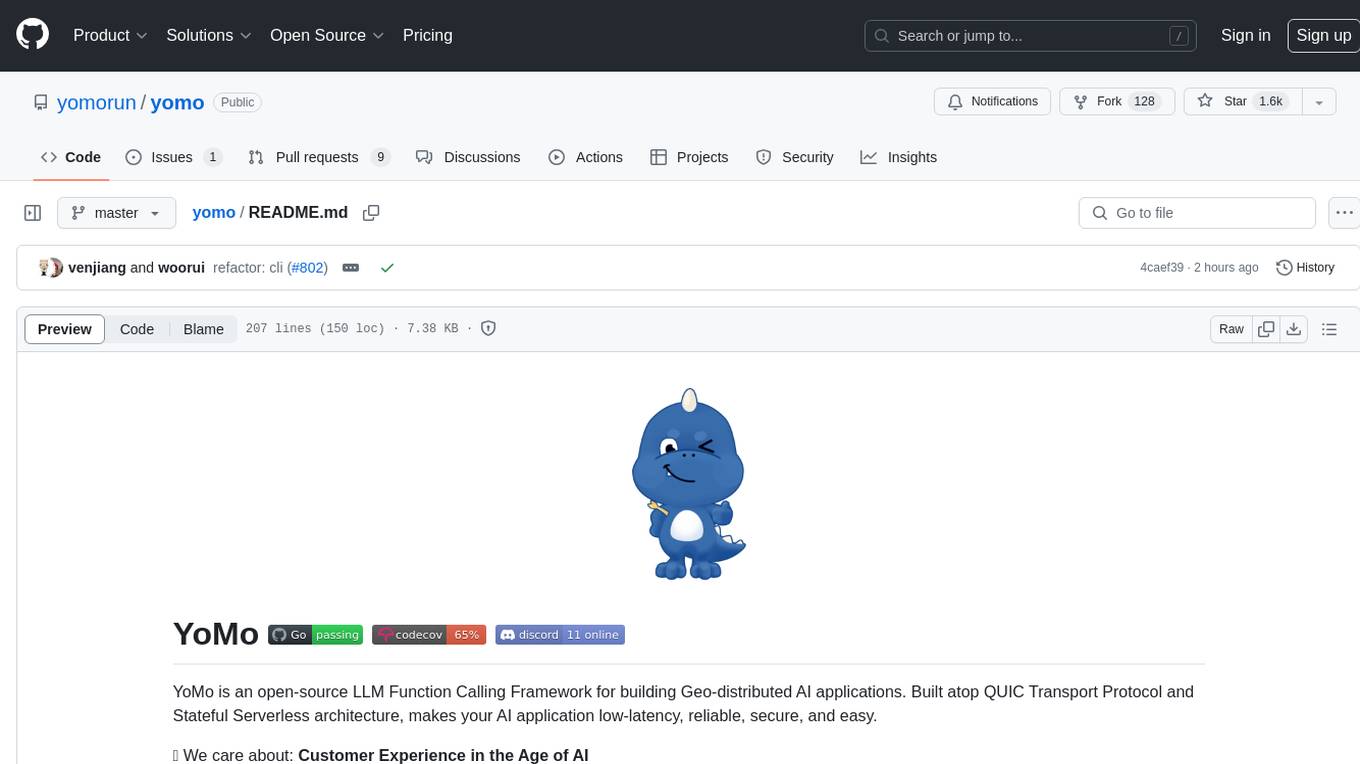
YoMo is an open-source LLM Function Calling Framework for building Geo-distributed AI applications. It is built atop QUIC Transport Protocol and Stateful Serverless architecture, making AI applications low-latency, reliable, secure, and easy. The framework focuses on providing low-latency, secure, stateful serverless functions that can be distributed geographically to bring AI inference closer to end users. It offers features such as low-latency communication, security with TLS v1.3, stateful serverless functions for faster GPU processing, geo-distributed architecture, and a faster-than-real-time codec called Y3. YoMo enables developers to create and deploy stateful serverless functions for AI inference in a distributed manner, ensuring quick responses to user queries from various locations worldwide.
README:
YoMo is an open-source LLM Function Calling Framework for building Geo-distributed AI applications. Built atop QUIC Transport Protocol and Stateful Serverless architecture, makes your AI application low-latency, reliable, secure, and easy.
💚 We care about: Customer Experience in the Age of AI
| Features | |
|---|---|
| ⚡️ | Low-latency Guaranteed by implementing atop QUIC QUIC |
| 🔐 | Security TLS v1.3 on every data packet by design |
| 📸 | Stateful Serverless Make your GPU serverless 10x faster |
| 🌎 | Geo-Distributed Architecture Brings AI inference closer to end users |
| 🚀 | Y3 a faster than real-time codec |
Let's implement a function calling with sfn-currency-converter:
curl -fsSL https://get.yomo.run | shVerify if the CLI was installed successfully
yomo versionPrepare the configuration as my-agent.yaml
name: ai-zipper
host: 0.0.0.0
port: 9000
auth:
type: token
token: SECRET_TOKEN
bridge:
ai:
server:
addr: 0.0.0.0:8000 ## Restful API endpoint
provider: openai ## LLM API Service we will use
providers:
azopenai:
api_endpoint: https://<RESOURCE>.openai.azure.com
deployment_id: <DEPLOYMENT_ID>
api_key: <API_KEY>
api_version: <API_VERSION>
openai:
api_key: sk-xxxxxxxxxxxxxxxxxxxxxxxxxxx
model: gpt-4-1106-preview
gemini:
api_key: <GEMINI_API_KEY>
cloudflare_azure:
endpoint: https://gateway.ai.cloudflare.com/v1/<CF_GATEWAY_ID>/<CF_GATEWAY_NAME>
api_key: <AZURE_API_KEY>
resource: <AZURE_OPENAI_RESOURCE>
deployment_id: <AZURE_OPENAI_DEPLOYMENT_ID>
api_version: 2023-12-01-previewStart the server:
YOMO_LOG_LEVEL=debug yomo serve -c my-agent.yamlFirst, let's define what this function do and how's the parameters required, these will be combined to prompt when invoking LLM.
type Parameter struct {
Domain string `json:"domain" jsonschema:"description=Domain of the website,example=example.com"`
}
func Description() string {
return `if user asks ip or network latency of a domain, you should return the result of the giving domain. try your best to dissect user expressions to infer the right domain names`
}
func InputSchema() any {
return &Parameter{}
}Create a Stateful Serverless Function to get the IP and Latency of a domain:
func Handler(ctx serverless.Context) {
var msg Parameter
ctx.ReadLLMArguments(&msg)
// get ip of the domain
ips, _ := net.LookupIP(msg.Domain)
// get ip[0] ping latency
pinger, _ := ping.NewPinger(ips[0].String())
pinger.Count = 3
pinger.Run()
stats := pinger.Statistics()
val := fmt.Sprintf("domain %s has ip %s with average latency %s", msg.Domain, ips[0], stats.AvgRtt)
ctx.WriteLLMResult(val)
}Finally, let's run it
$ yomo run app.go
time=2024-03-19T21:43:30.583+08:00 level=INFO msg="connected to zipper" component=StreamFunction sfn_id=B0ttNSEKLSgMjXidB11K1 sfn_name=fn-get-ip-from-domain zipper_addr=localhost:9000
time=2024-03-19T21:43:30.584+08:00 level=INFO msg="register ai function success" component=StreamFunction sfn_id=B0ttNSEKLSgMjXidB11K1 sfn_name=fn-get-ip-from-domain zipper_addr=localhost:9000 name=fn-get-ip-from-domain tag=16$ curl -i http://127.0.0.1:9000/v1/chat/completions -H "Content-Type: application/json" -d '{
"messages": [
{
"role": "system",
"content": "You are a test assistant."
},
{
"role": "user",
"content": "Compare website speed between Nike and Puma"
}
],
"stream": false
}'
HTTP/1.1 200 OK
Content-Length: 944
Connection: keep-alive
Content-Type: application/json
Date: Tue, 19 Mar 2024 13:30:14 GMT
Keep-Alive: timeout=4
Proxy-Connection: keep-alive
{
"Content": "Based on the data provided for the domains nike.com and puma.com which include IP addresses and average latencies, we can infer the following about their website speeds:
- Nike.com has an IP address of 13.225.183.84 with an average latency of 65.568333 milliseconds.
- Puma.com has an IP address of 151.101.194.132 with an average latency of 54.563666 milliseconds.
Comparing these latencies, Puma.com is faster than Nike.com as it has a lower average latency.
Please be aware, however, that website speed can be influenced by many factors beyond latency, such as server processing time, content size, and delivery networks among others. To get a more comprehensive understanding of website speed, you would need to consider additional metrics and possibly conductreal-time speed tests.",
"FinishReason": "stop"
}Full LLM Function Calling Codes
Read more about YoMo at yomo.run/docs.
YoMo ❤️ Vercel, our documentation website is
It’s no secret that today’s users want instant AI inference, every AI
application is more powerful when it response quickly. But, currently, when we
talk about distribution, it represents distribution in data center. The AI model is
far away from their users from all over the world.
If an application can be deployed anywhere close to their end users, solve the problem, this is Geo-distributed System Architecture:
First off, thank you for considering making contributions. It's people like you that make YoMo better. There are many ways in which you can participate in the project, for example:
- File a bug report. Be sure to include information like what version of YoMo you are using, what your operating system is, and steps to recreate the bug.
- Suggest a new feature.
- Read our contributing guidelines to learn about what types of contributions we are looking for.
- We have also adopted a code of conduct that we expect project participants to adhere to.
For Tasks:
Click tags to check more tools for each tasksFor Jobs:
Alternative AI tools for yomo
Similar Open Source Tools

yomo
YoMo is an open-source LLM Function Calling Framework for building Geo-distributed AI applications. It is built atop QUIC Transport Protocol and Stateful Serverless architecture, making AI applications low-latency, reliable, secure, and easy. The framework focuses on providing low-latency, secure, stateful serverless functions that can be distributed geographically to bring AI inference closer to end users. It offers features such as low-latency communication, security with TLS v1.3, stateful serverless functions for faster GPU processing, geo-distributed architecture, and a faster-than-real-time codec called Y3. YoMo enables developers to create and deploy stateful serverless functions for AI inference in a distributed manner, ensuring quick responses to user queries from various locations worldwide.
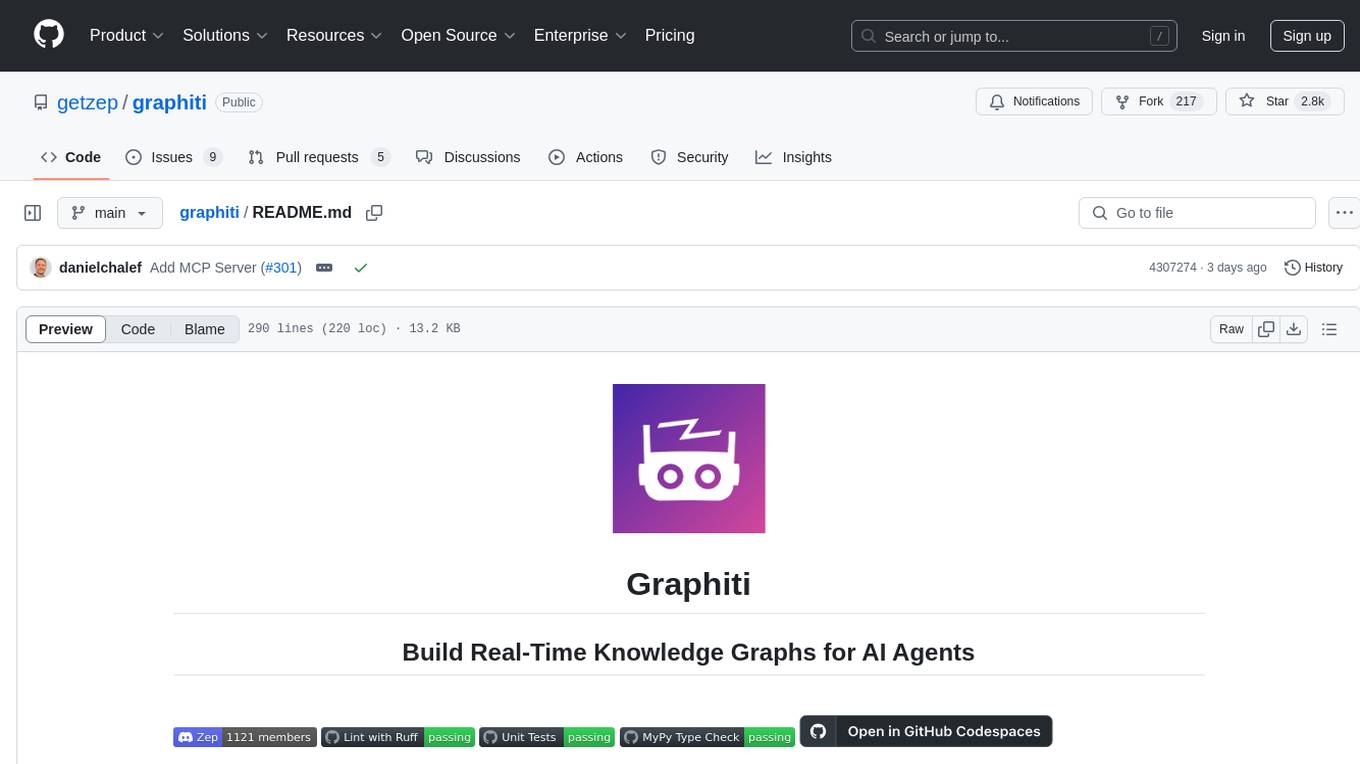
graphiti
Graphiti is a framework for building and querying temporally-aware knowledge graphs, tailored for AI agents in dynamic environments. It continuously integrates user interactions, structured and unstructured data, and external information into a coherent, queryable graph. The framework supports incremental data updates, efficient retrieval, and precise historical queries without complete graph recomputation, making it suitable for developing interactive, context-aware AI applications.
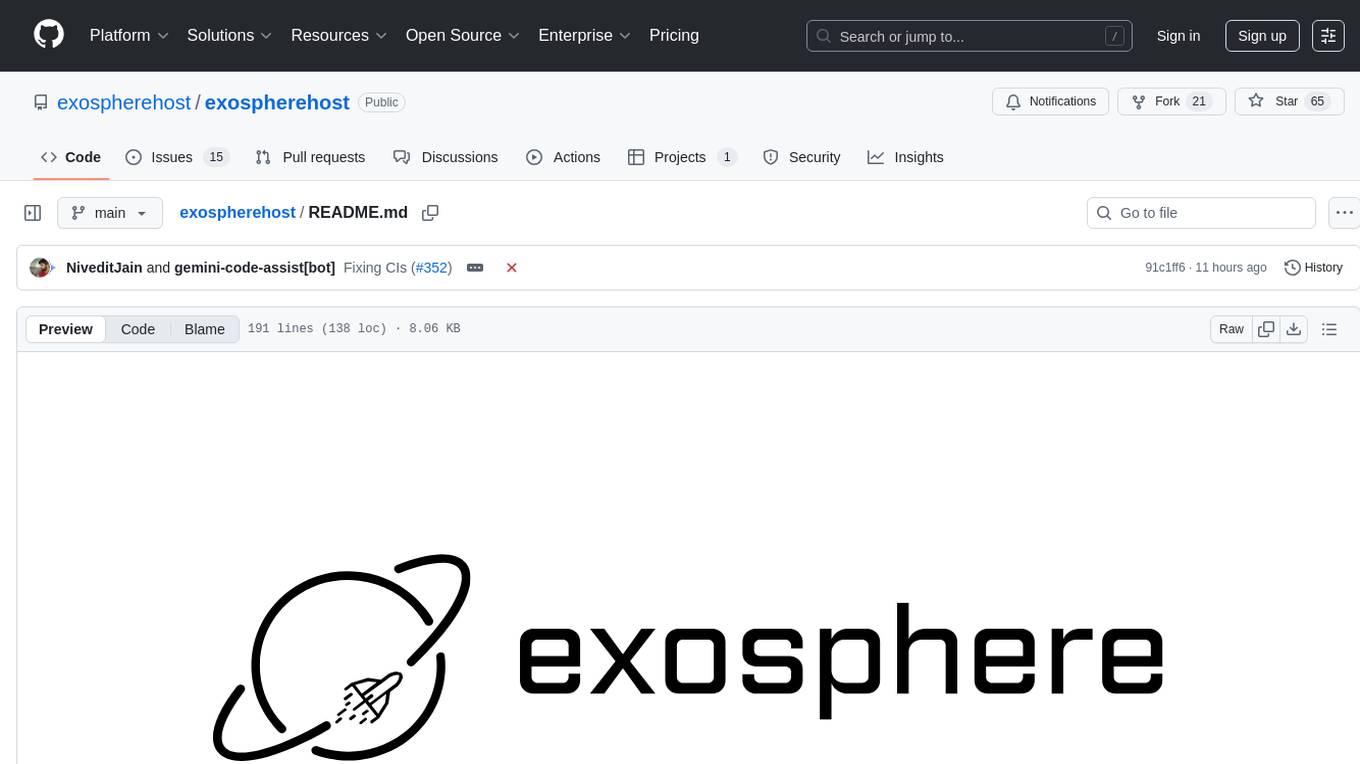
exospherehost
Exosphere is an open source infrastructure designed to run AI agents at scale for large data and long running flows. It allows developers to define plug and playable nodes that can be run on a reliable backbone in the form of a workflow, with features like dynamic state creation at runtime, infinite parallel agents, persistent state management, and failure handling. This enables the deployment of production agents that can scale beautifully to build robust autonomous AI workflows.
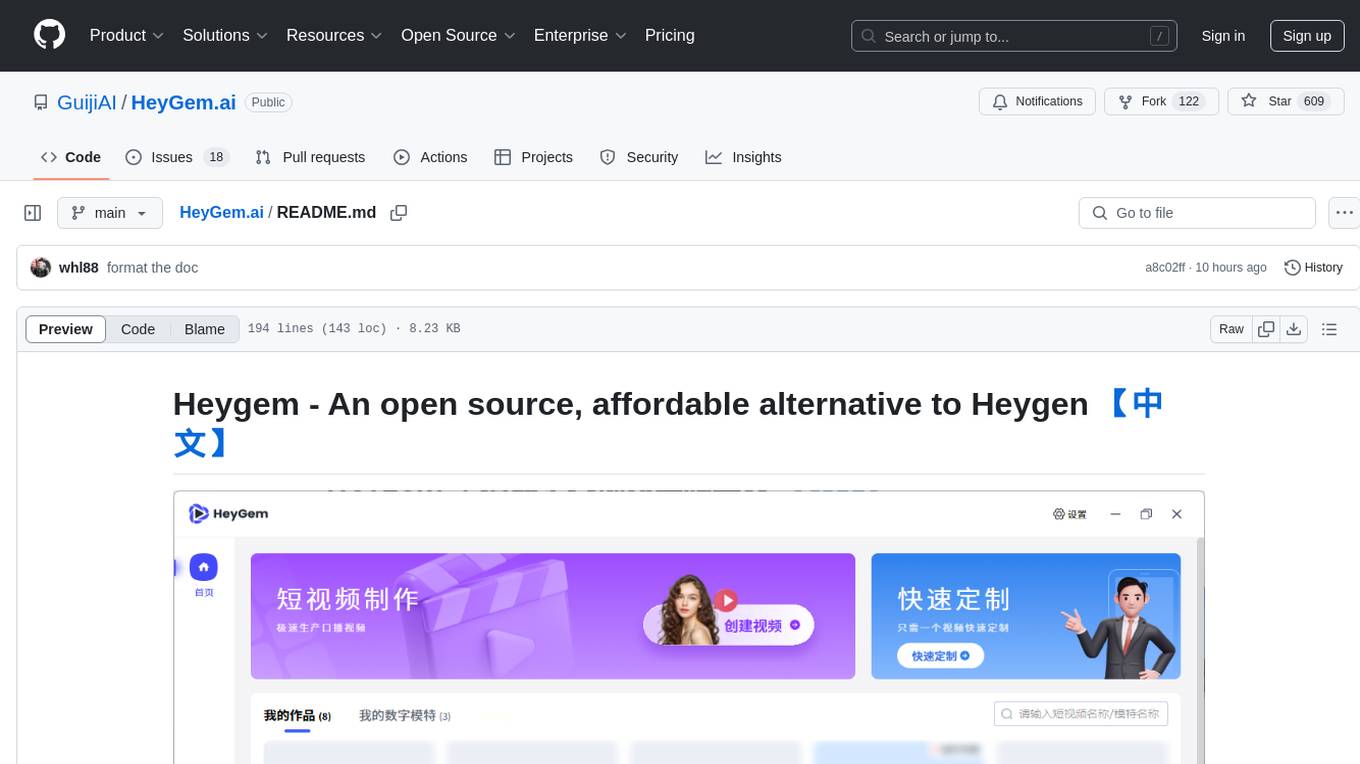
HeyGem.ai
Heygem is an open-source, affordable alternative to Heygen, offering a fully offline video synthesis tool for Windows systems. It enables precise appearance and voice cloning, allowing users to digitalize their image and drive virtual avatars through text and voice for video production. With core features like efficient video synthesis and multi-language support, Heygem ensures a user-friendly experience with fully offline operation and support for multiple models. The tool leverages advanced AI algorithms for voice cloning, automatic speech recognition, and computer vision technology to enhance the virtual avatar's performance and synchronization.
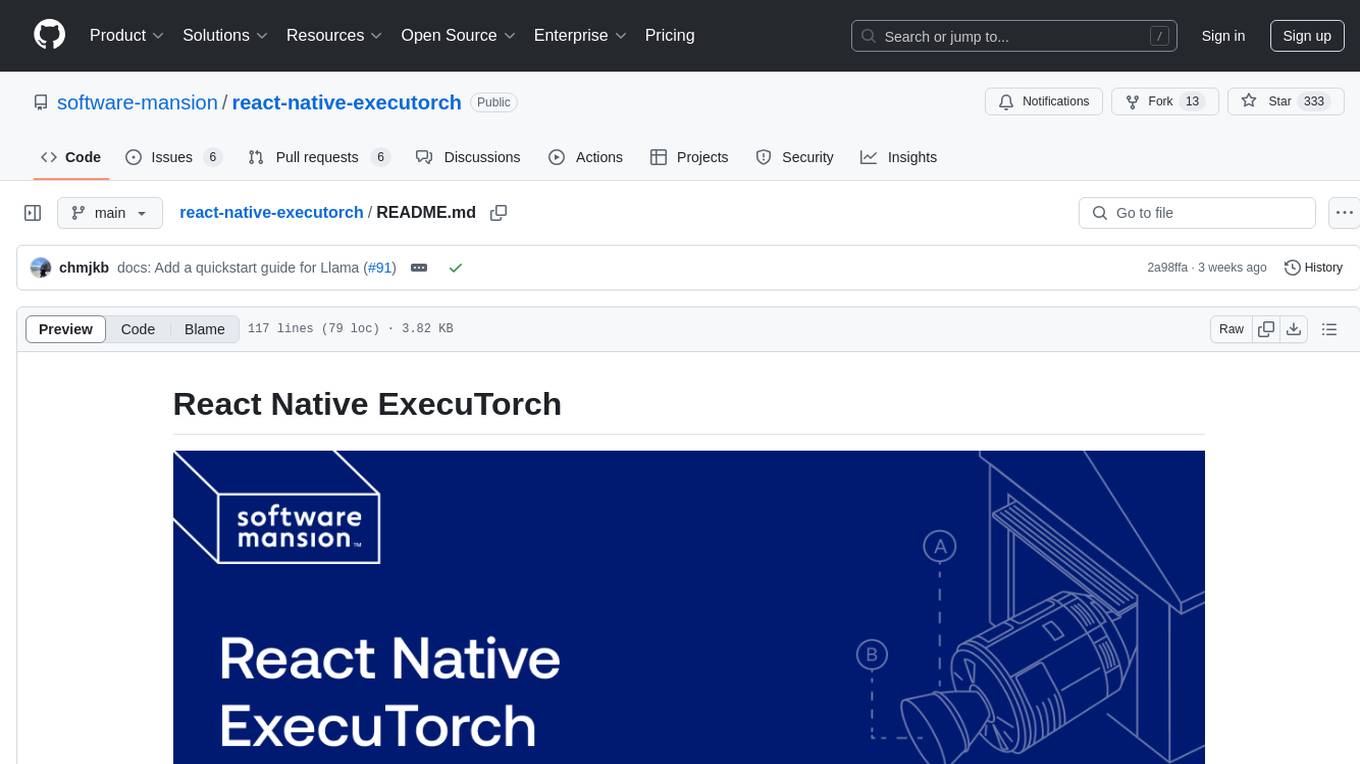
react-native-executorch
React Native ExecuTorch is a framework that allows developers to run AI models on mobile devices using React Native. It bridges the gap between React Native and native platform capabilities, providing high-performance AI model execution without requiring deep knowledge of native code or machine learning internals. The tool supports ready-made models in `.pte` format and offers a Python API for custom models. It is designed to simplify the integration of AI features into React Native apps.
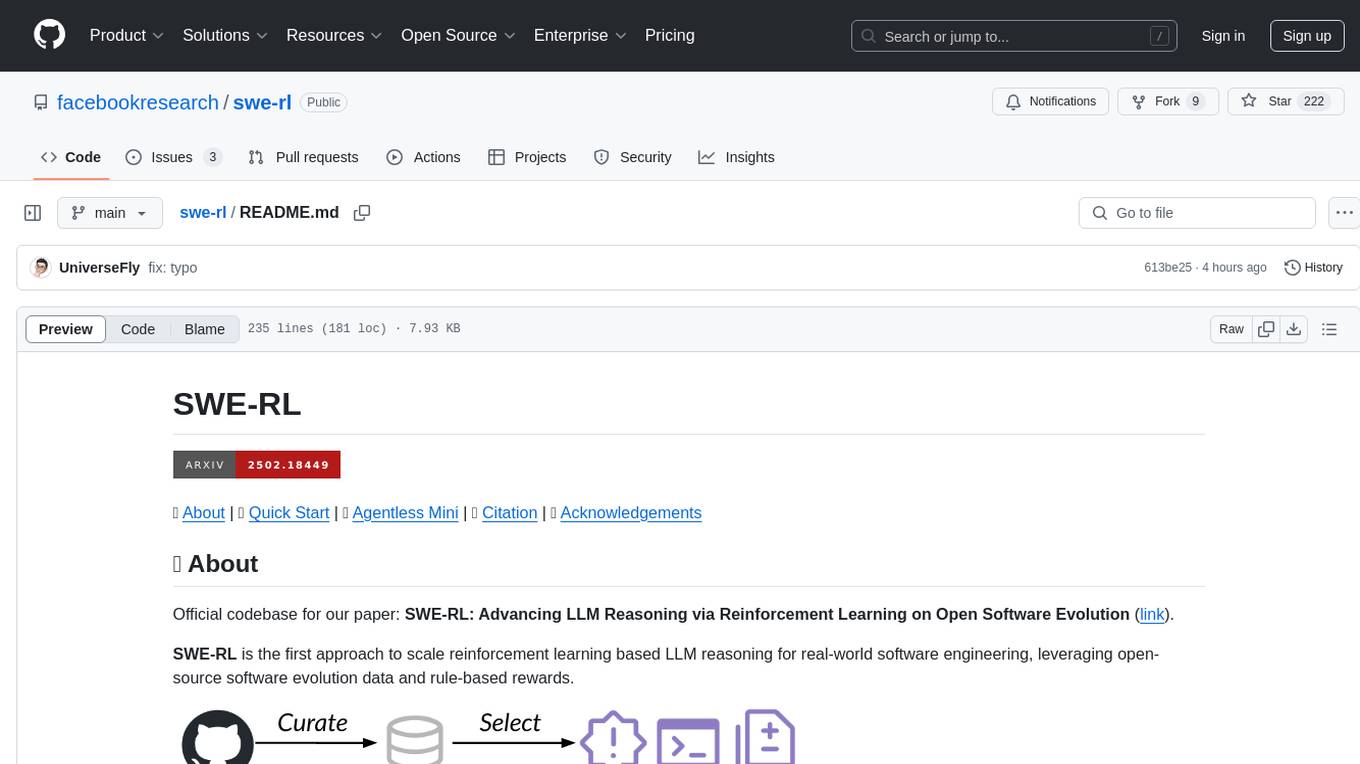
swe-rl
SWE-RL is the official codebase for the paper 'SWE-RL: Advancing LLM Reasoning via Reinforcement Learning on Open Software Evolution'. It is the first approach to scale reinforcement learning based LLM reasoning for real-world software engineering, leveraging open-source software evolution data and rule-based rewards. The code provides prompt templates and the implementation of the reward function based on sequence similarity. Agentless Mini, a part of SWE-RL, builds on top of Agentless with improvements like fast async inference, code refactoring for scalability, and support for using multiple reproduction tests for reranking. The tool can be used for localization, repair, and reproduction test generation in software engineering tasks.
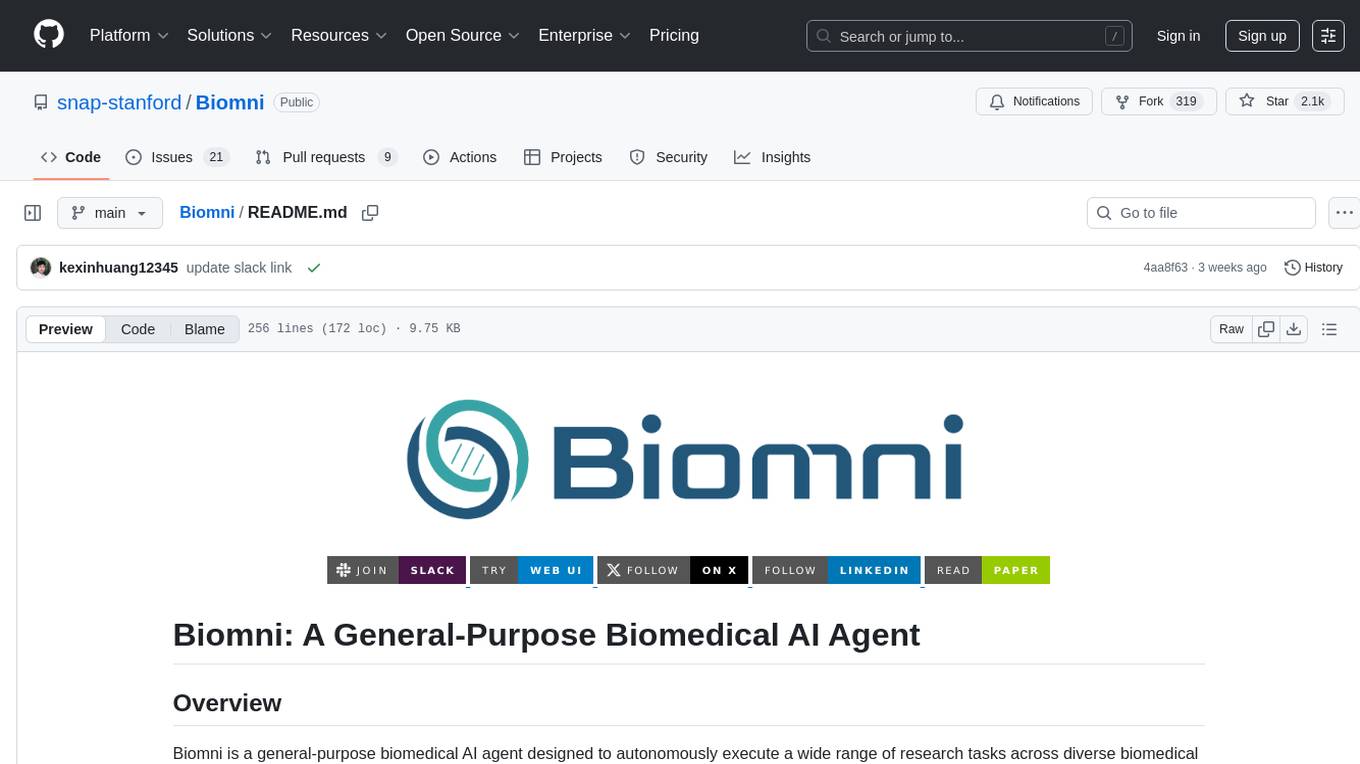
Biomni
Biomni is a general-purpose biomedical AI agent designed to autonomously execute a wide range of research tasks across diverse biomedical subfields. By integrating cutting-edge large language model (LLM) reasoning with retrieval-augmented planning and code-based execution, Biomni helps scientists dramatically enhance research productivity and generate testable hypotheses.
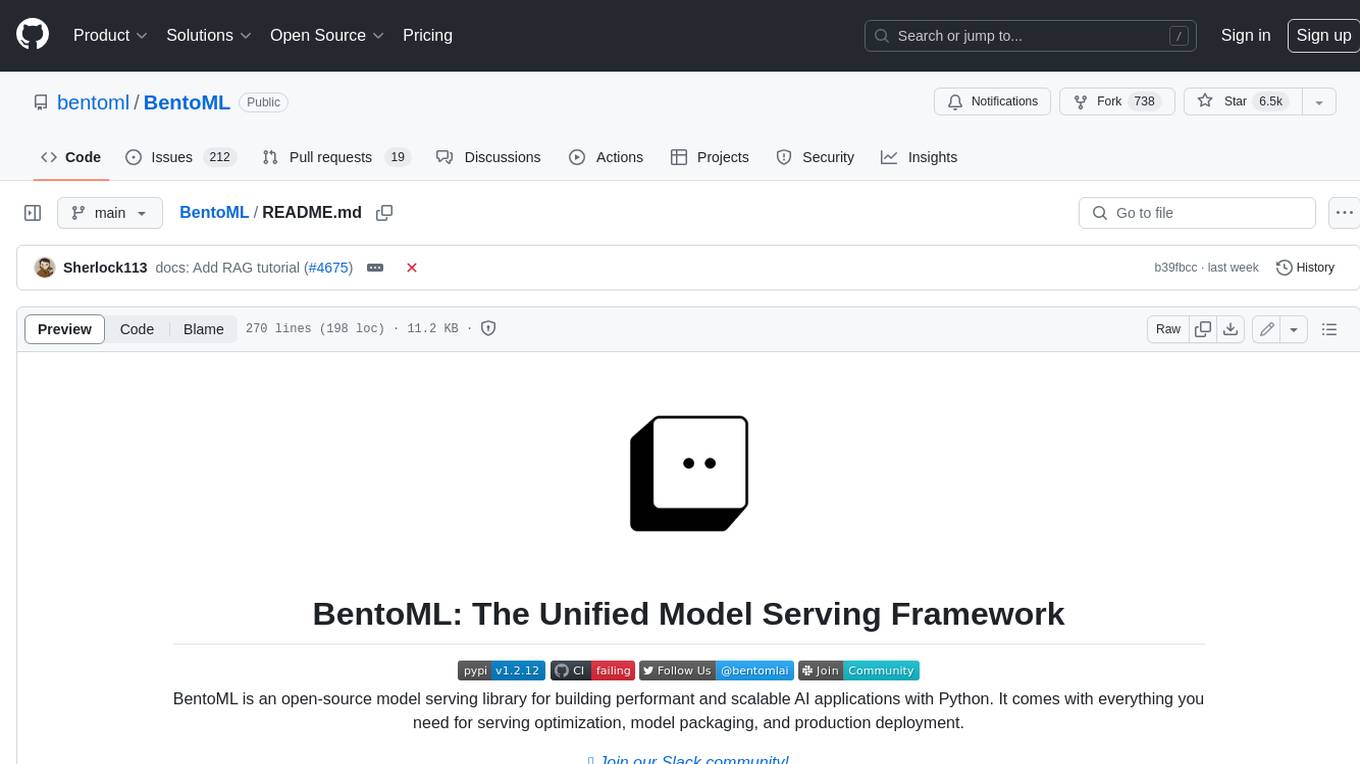
BentoML
BentoML is an open-source model serving library for building performant and scalable AI applications with Python. It comes with everything you need for serving optimization, model packaging, and production deployment.
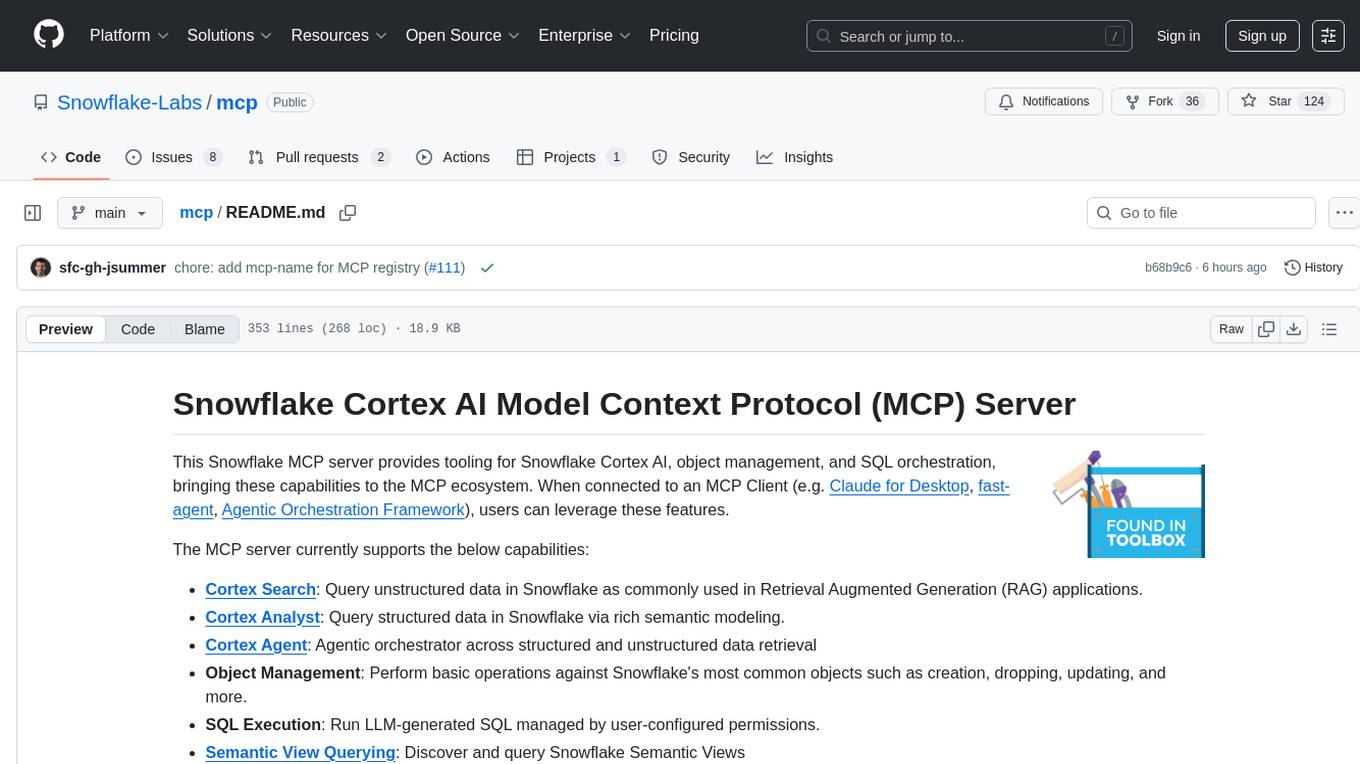
mcp
The Snowflake Cortex AI Model Context Protocol (MCP) Server provides tooling for Snowflake Cortex AI, object management, and SQL orchestration. It supports capabilities such as Cortex Search, Cortex Analyst, Cortex Agent, Object Management, SQL Execution, and Semantic View Querying. Users can connect to Snowflake using various authentication methods like username/password, key pair, OAuth, SSO, and MFA. The server is client-agnostic and works with MCP Clients like Claude Desktop, Cursor, fast-agent, Microsoft Visual Studio Code + GitHub Copilot, and Codex. It includes tools for Object Management (creating, dropping, describing, listing objects), SQL Execution (executing SQL statements), and Semantic View Querying (discovering, querying Semantic Views). Troubleshooting can be done using the MCP Inspector tool.
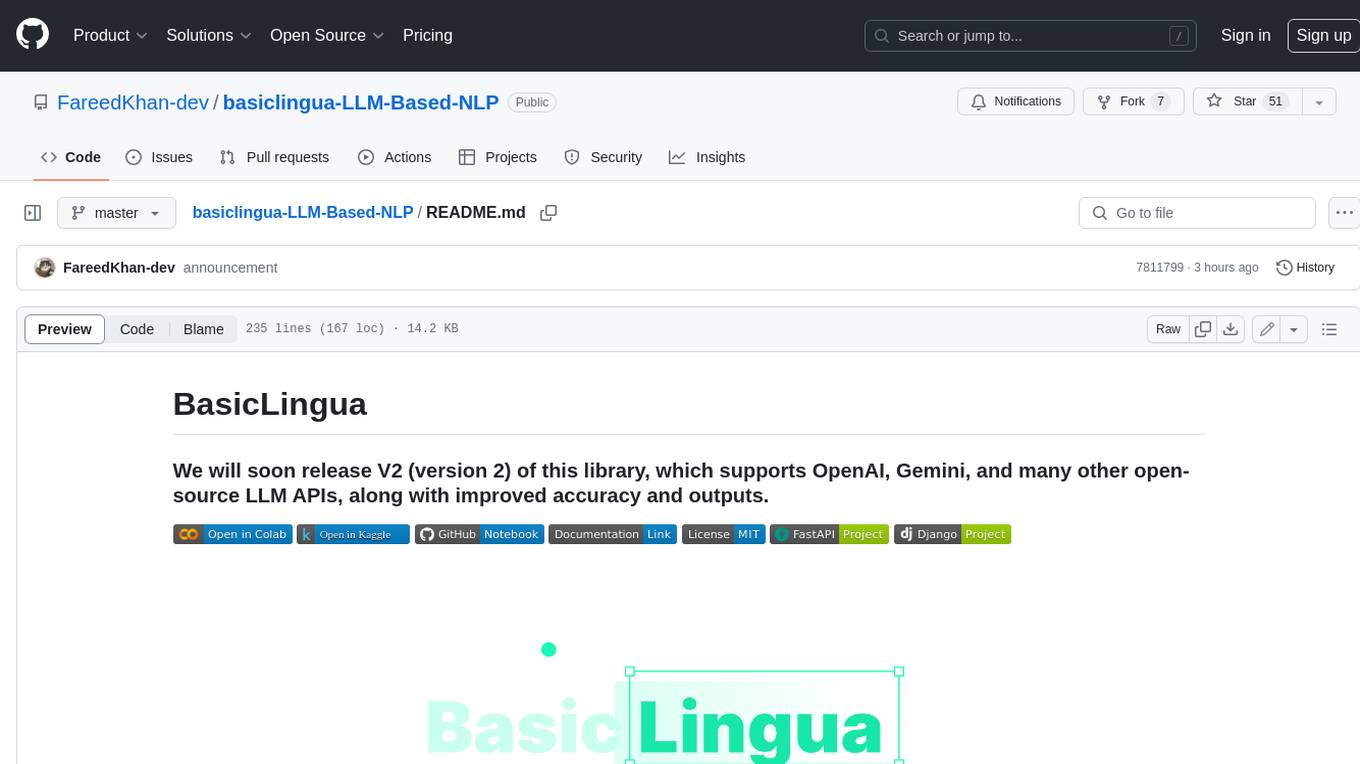
basiclingua-LLM-Based-NLP
BasicLingua is a Python library that provides functionalities for linguistic tasks such as tokenization, stemming, lemmatization, and many others. It is based on the Gemini Language Model, which has demonstrated promising results in dealing with text data. BasicLingua can be used as an API or through a web demo. It is available under the MIT license and can be used in various projects.

call-center-ai
Call Center AI is an AI-powered call center solution leveraging Azure and OpenAI GPT. It allows for AI agent-initiated phone calls or direct calls to the bot from a configured phone number. The bot is customizable for various industries like insurance, IT support, and customer service, with features such as accessing claim information, conversation history, language change, SMS sending, and more. The project is a proof of concept showcasing the integration of Azure Communication Services, Azure Cognitive Services, and Azure OpenAI for an automated call center solution.
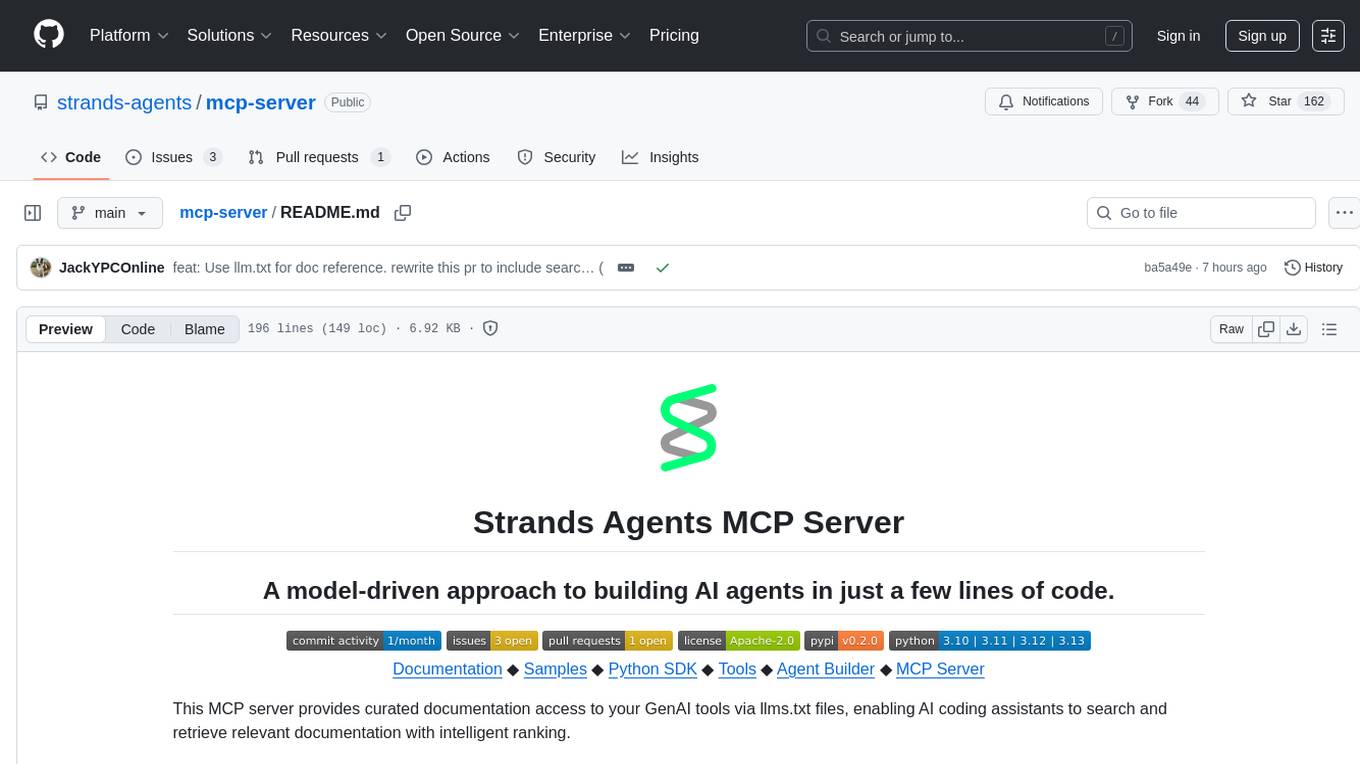
mcp-server
The Strands Agents MCP Server is a model-driven approach to building AI agents in just a few lines of code. It provides curated documentation access to GenAI tools via llms.txt files, enabling AI coding assistants to search and retrieve relevant documentation with intelligent ranking. Features include smart document search, curated content indexing, on-demand fetching, snippet generation, and real URL support. The server can be used with various applications that support MCP servers, such as Amazon Q Developer CLI, Anthropic Claude Code, Cline, and Cursor. Users can quickly test the MCP server using the MCP Inspector and follow the provided steps to configure their MCP client and start using the documentation tools. The project welcomes contributions and is licensed under the Apache License 2.0.
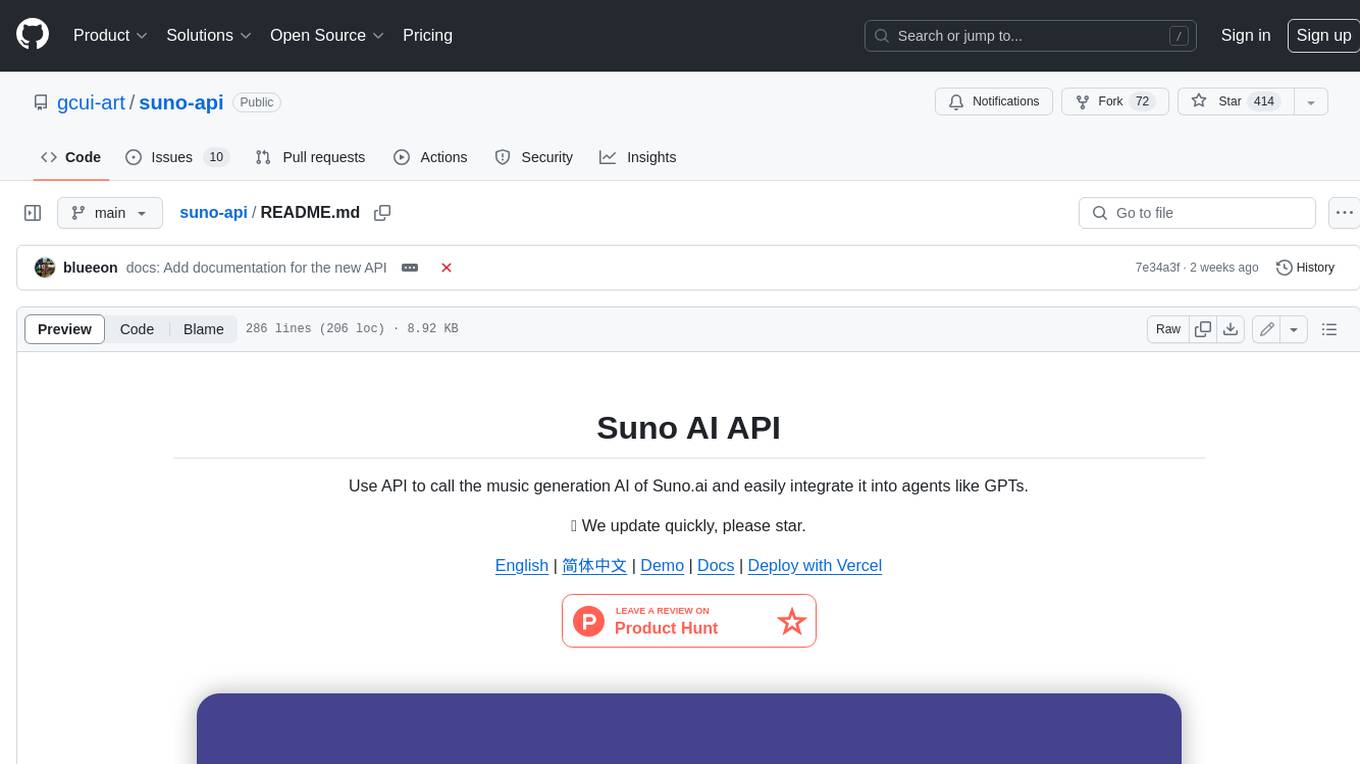
suno-api
Suno AI API is an open-source project that allows developers to integrate the music generation capabilities of Suno.ai into their own applications. The API provides a simple and convenient way to generate music, lyrics, and other audio content using Suno.ai's powerful AI models. With Suno AI API, developers can easily add music generation functionality to their apps, websites, and other projects.
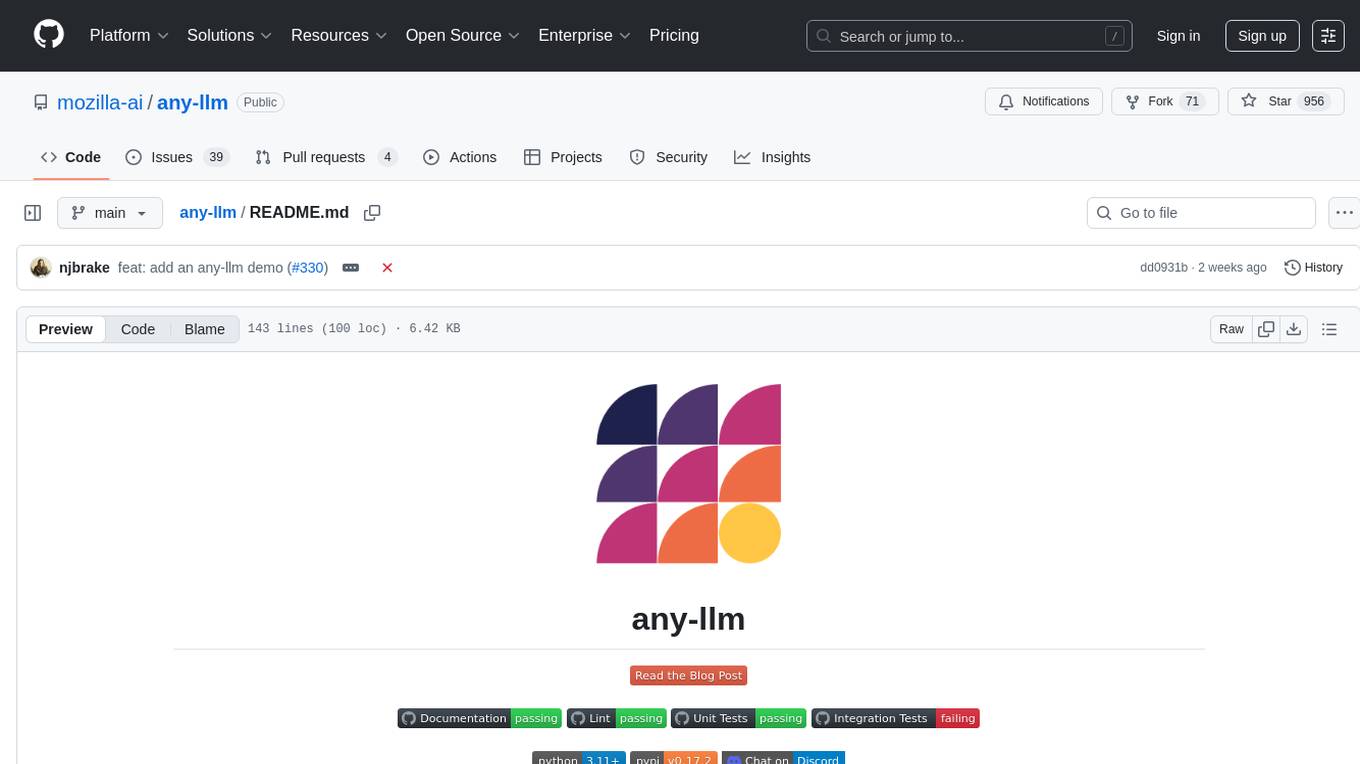
any-llm
The `any-llm` repository provides a unified API to access different LLM (Large Language Model) providers. It offers a simple and developer-friendly interface, leveraging official provider SDKs for compatibility and maintenance. The tool is framework-agnostic, actively maintained, and does not require a proxy or gateway server. It addresses challenges in API standardization and aims to provide a consistent interface for various LLM providers, overcoming limitations of existing solutions like LiteLLM, AISuite, and framework-specific integrations.
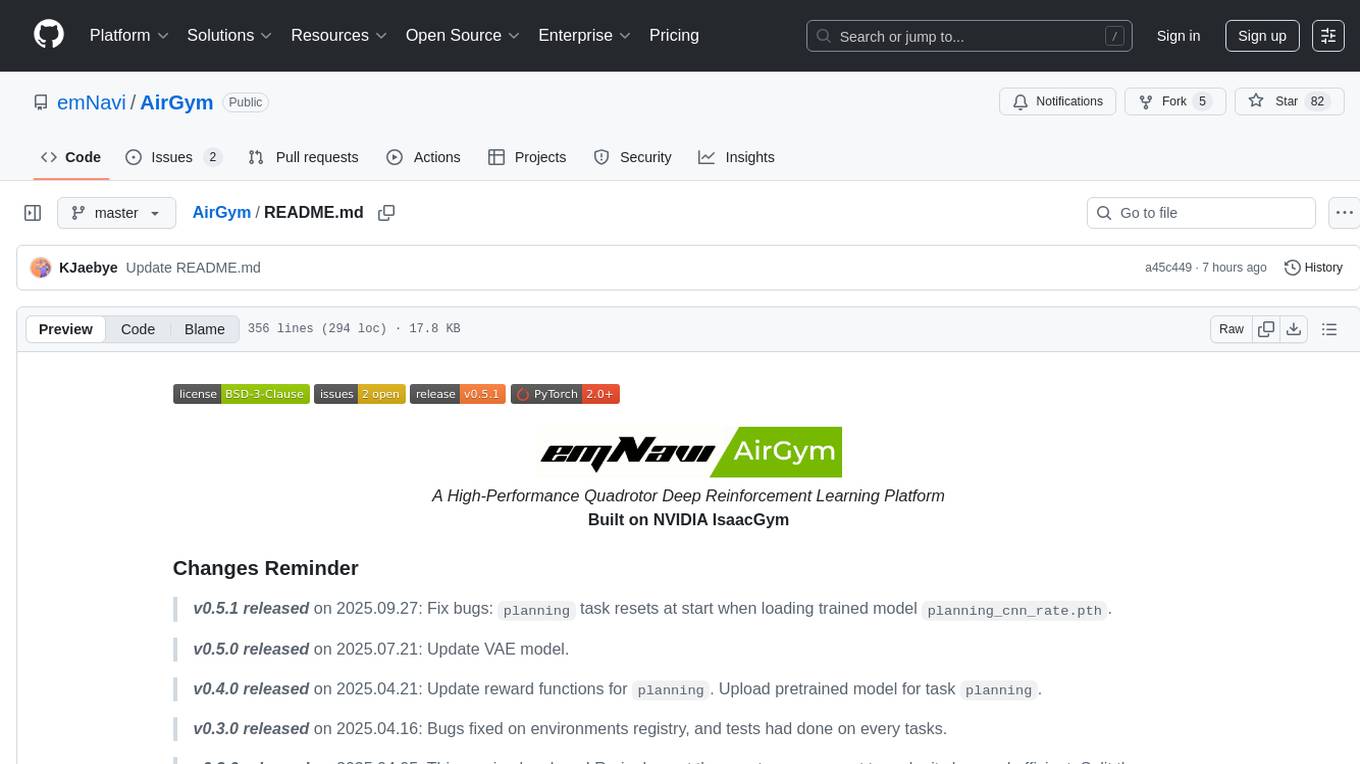
AirGym
AirGym is an open source Python quadrotor simulator based on IsaacGym, providing a high-fidelity dynamics and Deep Reinforcement Learning (DRL) framework for quadrotor robot learning research. It offers a lightweight and customizable platform with strict alignment with PX4 logic, multiple control modes, and Sim-to-Real toolkits. Users can perform tasks such as Hovering, Balloon, Tracking, Avoid, and Planning, with the ability to create customized environments and tasks. The tool also supports training from scratch, visual encoding approaches, playing and testing of trained models, and customization of new tasks and assets.
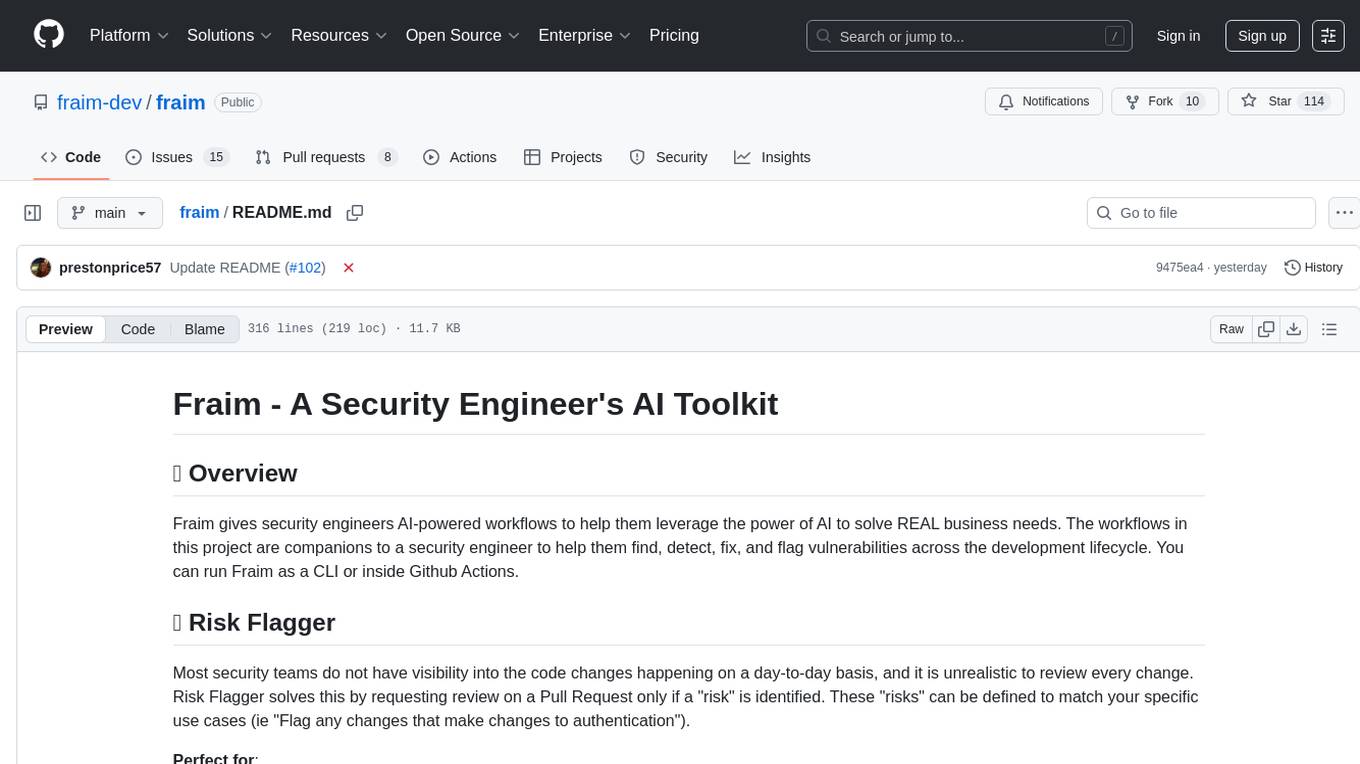
fraim
Fraim is an AI-powered toolkit designed for security engineers to enhance their workflows by leveraging AI capabilities. It offers solutions to find, detect, fix, and flag vulnerabilities throughout the development lifecycle. The toolkit includes features like Risk Flagger for identifying risks in code changes, Code Security Analysis for context-aware vulnerability detection, and Infrastructure as Code Analysis for spotting misconfigurations in cloud environments. Fraim can be run as a CLI tool or integrated into Github Actions, making it a versatile solution for security teams and organizations looking to enhance their security practices with AI technology.
For similar tasks

yomo
YoMo is an open-source LLM Function Calling Framework for building Geo-distributed AI applications. It is built atop QUIC Transport Protocol and Stateful Serverless architecture, making AI applications low-latency, reliable, secure, and easy. The framework focuses on providing low-latency, secure, stateful serverless functions that can be distributed geographically to bring AI inference closer to end users. It offers features such as low-latency communication, security with TLS v1.3, stateful serverless functions for faster GPU processing, geo-distributed architecture, and a faster-than-real-time codec called Y3. YoMo enables developers to create and deploy stateful serverless functions for AI inference in a distributed manner, ensuring quick responses to user queries from various locations worldwide.
For similar jobs

sweep
Sweep is an AI junior developer that turns bugs and feature requests into code changes. It automatically handles developer experience improvements like adding type hints and improving test coverage.

teams-ai
The Teams AI Library is a software development kit (SDK) that helps developers create bots that can interact with Teams and Microsoft 365 applications. It is built on top of the Bot Framework SDK and simplifies the process of developing bots that interact with Teams' artificial intelligence capabilities. The SDK is available for JavaScript/TypeScript, .NET, and Python.

ai-guide
This guide is dedicated to Large Language Models (LLMs) that you can run on your home computer. It assumes your PC is a lower-end, non-gaming setup.

classifai
Supercharge WordPress Content Workflows and Engagement with Artificial Intelligence. Tap into leading cloud-based services like OpenAI, Microsoft Azure AI, Google Gemini and IBM Watson to augment your WordPress-powered websites. Publish content faster while improving SEO performance and increasing audience engagement. ClassifAI integrates Artificial Intelligence and Machine Learning technologies to lighten your workload and eliminate tedious tasks, giving you more time to create original content that matters.

chatbot-ui
Chatbot UI is an open-source AI chat app that allows users to create and deploy their own AI chatbots. It is easy to use and can be customized to fit any need. Chatbot UI is perfect for businesses, developers, and anyone who wants to create a chatbot.

BricksLLM
BricksLLM is a cloud native AI gateway written in Go. Currently, it provides native support for OpenAI, Anthropic, Azure OpenAI and vLLM. BricksLLM aims to provide enterprise level infrastructure that can power any LLM production use cases. Here are some use cases for BricksLLM: * Set LLM usage limits for users on different pricing tiers * Track LLM usage on a per user and per organization basis * Block or redact requests containing PIIs * Improve LLM reliability with failovers, retries and caching * Distribute API keys with rate limits and cost limits for internal development/production use cases * Distribute API keys with rate limits and cost limits for students

uAgents
uAgents is a Python library developed by Fetch.ai that allows for the creation of autonomous AI agents. These agents can perform various tasks on a schedule or take action on various events. uAgents are easy to create and manage, and they are connected to a fast-growing network of other uAgents. They are also secure, with cryptographically secured messages and wallets.

griptape
Griptape is a modular Python framework for building AI-powered applications that securely connect to your enterprise data and APIs. It offers developers the ability to maintain control and flexibility at every step. Griptape's core components include Structures (Agents, Pipelines, and Workflows), Tasks, Tools, Memory (Conversation Memory, Task Memory, and Meta Memory), Drivers (Prompt and Embedding Drivers, Vector Store Drivers, Image Generation Drivers, Image Query Drivers, SQL Drivers, Web Scraper Drivers, and Conversation Memory Drivers), Engines (Query Engines, Extraction Engines, Summary Engines, Image Generation Engines, and Image Query Engines), and additional components (Rulesets, Loaders, Artifacts, Chunkers, and Tokenizers). Griptape enables developers to create AI-powered applications with ease and efficiency.


